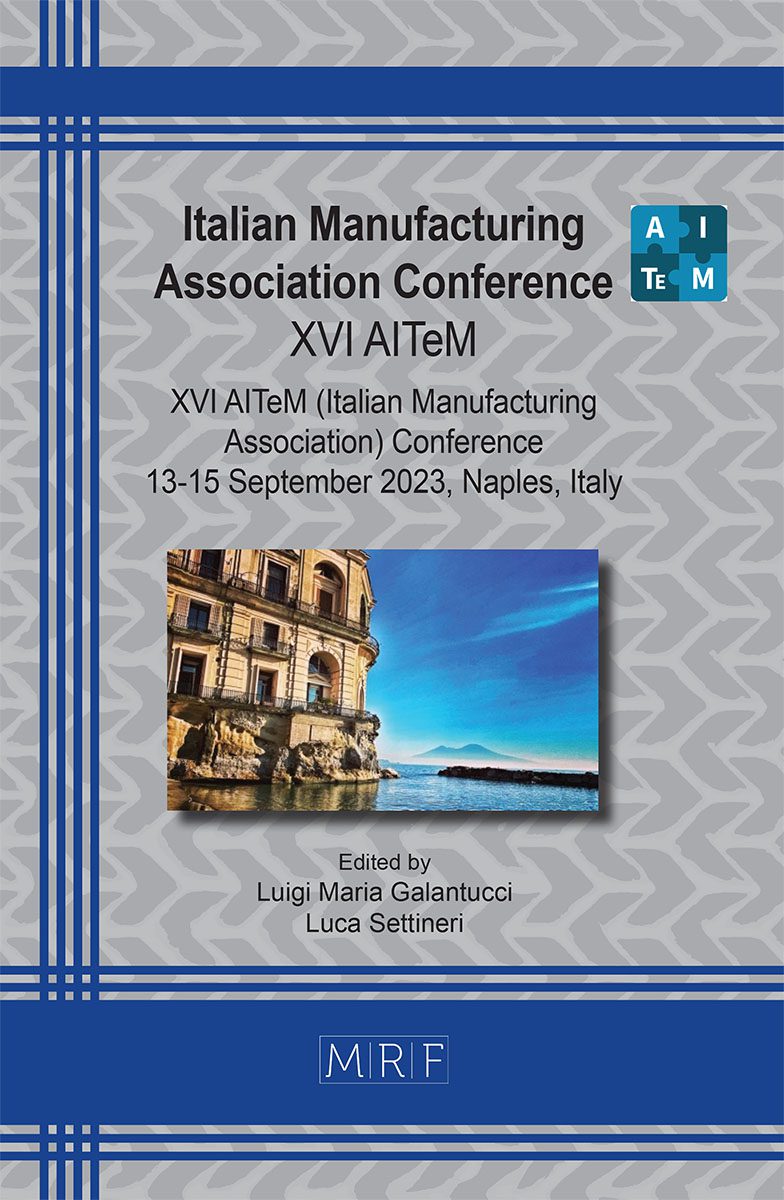Development of depositions strategies for edge repair using a WAAM process
Francesco Baffa, Giuseppe Venturini, Gianni Campatelli
download PDFAbstract. Remanufacturing is an industrial process able to restore a component to at least its original performance, and it is considered one of the key processes to support the transition to circular economy. For restoring a metal component, additive manufacturing processes based on Direct Energy Deposition (DED) techniques are the most widely used, since they can process a damaged part with a complex geometry. Among these, Wire Arc Additive Manufacturing (WAAM) has several advantages including a high deposition rate, lower operative, material, and equipment costs. Nevertheless, it is also characterized by low accuracy and a high risk of defects if the process is not tuned correctly. It is therefore crucial to develop smart deposition strategies to ensure defect-free deposition and high efficiency. This study focuses on the repair of steel edges, and specific toolpaths has been designed and tested for repairing this geometrical feature, both concave and convex, coupled with the selection of proper welding parameters and torch tilting angle.
Keywords
Wire Arc Additive Manufacturing (WAAM), Circular Economy, Remanufacturing
Published online 9/5/2023, 9 pages
Copyright © 2023 by the author(s)
Published under license by Materials Research Forum LLC., Millersville PA, USA
Citation: Francesco Baffa, Giuseppe Venturini, Gianni Campatelli, Development of depositions strategies for edge repair using a WAAM process, Materials Research Proceedings, Vol. 35, pp 467-475, 2023
DOI: https://doi.org/10.21741/9781644902714-55
The article was published as article 55 of the book Italian Manufacturing Association Conference
![]() Content from this work may be used under the terms of the Creative Commons Attribution 3.0 license. Any further distribution of this work must maintain attribution to the author(s) and the title of the work, journal citation and DOI.
Content from this work may be used under the terms of the Creative Commons Attribution 3.0 license. Any further distribution of this work must maintain attribution to the author(s) and the title of the work, journal citation and DOI.
References
[1] European Commission, “A new Circular Economy Action Plan,” 2020.
[2] T. Ibn-Mohammed, K. B. Mustapha, J. Godsell, Z. Adamu, K. A. Babatunde, D. D. Akintade, A. Acquaye, H. Fujii, M. M. Ndiaye, F. A. Yamoah, and S. C. L. Koh, “A critical review of the impacts of COVID-19 on the global economy and ecosystems and opportunities for circular economy strategies,” Resour. Conserv. Recycl., vol.164, 2021. https://doi.org/10.1016/j.resconrec.2020.105169
[3] J. Russell and N. Nasr, “Value‐Retention Processes within the Circular Economy,” in Remanufacturing in the Circular Economy, 1st ed., N. Nasr, ed. Wiley, 2019, pp.1-29. https://doi.org/10.1002/9781119664383.ch1
[4] C.-M. Lee, W.-S. Woo, and Y.-H. Roh, “Remanufacturing: Trends and issues,” Int. J. Precis. Eng. Manuf.-Green Technol., vol.4, no. 1, pp.113-125, Jan. 2017. https://doi.org/10.1007/s40684-017-0015-0
[5] R. Chen, H. Yin, I. S. Cole, S. Shen, X. Zhou, Y. Wang, and S. Tang, “Exposure, assessment and health hazards of particulate matter in metal additive manufacturing: A review,” Chemosphere, vol.259, p.127452, Nov. 2020. https://doi.org/10.1016/j.chemosphere.2020.127452
[6] A. Wippermann, T. G. Gutowski, B. Denkena, M.-A. Dittrich, and Y. Wessarges, “Electrical energy and material efficiency analysis of machining, additive and hybrid manufacturing,” J. Clean. Prod., vol.251, p.119731, Apr. 2020. https://doi.org/10.1016/j.jclepro.2019.119731
[7] B. Wu, Z. Pan, D. Ding, D. Cuiuri, H. Li, J. Xu, and J. Norrish, “A review of the wire arc additive manufacturing of metals: properties, defects and quality improvement,” J. Manuf. Process., vol.35, pp.127-139, Oct. 2018. https://doi.org/10.1016/j.jmapro.2018.08.001
[8] J. M. Wilson, C. Piya, Y. C. Shin, F. Zhao, and K. Ramani, “Remanufacturing of turbine blades by laser direct deposition with its energy and environmental impact analysis,” J. Clean. Prod., vol.80, pp.170-178, Oct. 2014. https://doi.org/10.1016/j.jclepro.2014.05.084
[9] C. Chen, Y. Wang, H. Ou, Y. He, and X. Tang, “A review on remanufacture of dies and moulds,” J. Clean. Prod., vol.64, pp.13-23, Feb. 2014. https://doi.org/10.1016/j.jclepro.2013.09.014
[10] M. Vishnukumar, R. Pramod, and A. Rajesh Kannan, “Wire arc additive manufacturing for repairing aluminium structures in marine applications,” Mater. Lett., vol.299, p.130112, Sep. 2021. https://doi.org/10.1016/j.matlet.2021.130112
[11] G. Campatelli, G. Venturini, N. Grossi, F. Baffa, A. Scippa, and K. Yamazaki, “Design and testing of a waam retrofit kit for repairing operations on a milling machine,” Machines, vol.9, no. 12, 2021. https://doi.org/10.3390/machines9120322
[12] D. Ding, Z. Pan, D. Cuiuri, and H. Li, “A multi-bead overlapping model for robotic wire and arc additive manufacturing (WAAM),” Robot. Comput.-Integr. Manuf., vol.31, pp.101-110, Feb. 2015. https://doi.org/10.1016/j.rcim.2014.08.008
[13] C. G. Pickin, S. W. Williams, and M. Lunt, “Characterisation of the cold metal transfer (CMT) process and its application for low dilution cladding,” J. Mater. Process. Technol., vol.211, no. 3, pp.496-502, Mar. 2011. https://doi.org/10.1016/j.jmatprotec.2010.11.005
[14] F. Baffa, G. Venturini, G. Campatelli, and E. Galvanetto, “Effect of stepover and torch tilting angle on a repair process using WAAM,” Adv. Manuf., vol.10, no. 4, pp.541-555, Dec. 2022. https://doi.org/10.1007/s40436-022-00393-2































